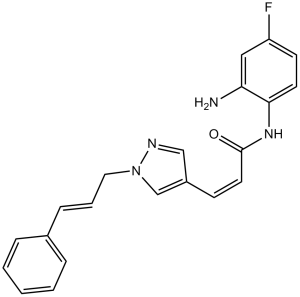RGFP966 (RGF-P966) is a novel, potent and highly selective inhibitor of HDAC3 (histone deacetylase 3) with potential anticancer activity. In a cell-free assay, it inhibits HDAC3 with an IC50 of 80 nM and shows >200-fold selectivity for HDAC3 over other HDACs.
Physicochemical Properties
| Molecular Formula | C21H19FN4O | |
| Molecular Weight | 362.4 | |
| Exact Mass | 362.154 | |
| Elemental Analysis | C, 69.60; H, 5.28; F, 5.24; N, 15.46; O, 4.41 | |
| CAS # | 1357389-11-7 | |
| Related CAS # |
|
|
| PubChem CID | 56650312 | |
| Appearance | White solid powder | |
| Density | 1.2±0.1 g/cm3 | |
| Boiling Point | 630.4±55.0 °C at 760 mmHg | |
| Flash Point | 335.0±31.5 °C | |
| Vapour Pressure | 0.0±1.8 mmHg at 25°C | |
| Index of Refraction | 1.607 | |
| LogP | 3.95 | |
| Hydrogen Bond Donor Count | 2 | |
| Hydrogen Bond Acceptor Count | 4 | |
| Rotatable Bond Count | 6 | |
| Heavy Atom Count | 27 | |
| Complexity | 532 | |
| Defined Atom Stereocenter Count | 0 | |
| SMILES | O=C(NC1=CC=C(F)C=C1N)/C=C/C2=CN(C/C=C/C3=CC=CC=C3)N=C2.[E] |
|
| InChi Key | BLVQHYHDYFTPDV-VCABWLAWSA-N | |
| InChi Code | InChI=1S/C21H19FN4O/c22-18-9-10-20(19(23)13-18)25-21(27)11-8-17-14-24-26(15-17)12-4-7-16-5-2-1-3-6-16/h1-11,13-15H,12,23H2,(H,25,27)/b7-4+,11-8+ | |
| Chemical Name | (E)-N-(2-amino-4-fluorophenyl)-3-[1-[(E)-3-phenylprop-2-enyl]pyrazol-4-yl]prop-2-enamide | |
| Synonyms | RGFP966; RGFP-966; 1396841-57-8; (E)-N-(2-amino-4-fluorophenyl)-3-(1-cinnamyl-1H-pyrazol-4-yl)acrylamide; RGFP 966; RGFP-966; (E,E)-RGFP966; CHEMBL4078477; RGFP 966 | |
| HS Tariff Code | 2934.99.9001 | |
| Storage |
Powder-20°C 3 years 4°C 2 years In solvent -80°C 6 months -20°C 1 month |
|
| Shipping Condition | Room temperature (This product is stable at ambient temperature for a few days during ordinary shipping and time spent in Customs) |
Biological Activity
| Targets | HDAC3 ( IC50 = 80 nM ) | |
| ln Vitro |
|
|
| ln Vivo |
|
|
| Enzyme Assay | Assays for acetylation are derived from the homogenous fluorescence release method. Following pre-incubation periods ranging from 0 to 3 hours, purified recombinant enzymes are incubated in the standard HDAC buffer with serially diluted inhibitors at the concentrations shown in the figures. After pre-incubation, acetyl-Lys(Ac)-AMC substrate (at 10 μM, corresponding to the Km for both HDAC1 and HDAC3) is added. An hour is given for the reaction to continue. An Tecan M200 96-well plate reader is used to measure the fluorescence emission after an hour of adding the trypsin peptidase developer at a final concentration of 5 mg/ml. | |
| Cell Assay | At 26105 cells/mL, cells are counted and divided into T25 (Corning) flasks. After that, cells are treated once at hour 0 with either DMSO or HDIs. At 0, 24, 48, and 72 hours following treatment, 100 ml aliquots are taken in triplicate from each flask, distributed into a flat bottom 96-well plate, and 10 ml of alamar blue is added to each well. Using the Biotek Synergy MX Microplate Reader, fluorescence is measured after a 4-hour incubation period. | |
| Animal Protocol |
|
|
| References |
[1]. Proc Natl Acad Sci U S A . 2013 Feb 12;110(7):2647-52. [2]. PLoS One . 2013 Jul 22;8(7):e68915. |
|
| Additional Infomation | N-(2-amino-4-fluorophenyl)-3-[1-(3-phenylprop-2-enyl)-4-pyrazolyl]-2-propenamide is an aromatic amide and an aromatic amine. |
Solubility Data
| Solubility (In Vitro) |
|
|||
| Solubility (In Vivo) |
Solubility in Formulation 1: ≥ 2.5 mg/mL (6.90 mM) (saturation unknown) in 10% DMSO + 40% PEG300 + 5% Tween80 + 45% Saline (add these co-solvents sequentially from left to right, and one by one), clear solution. For example, if 1 mL of working solution is to be prepared, you can add 100 μL of 25.0 mg/mL clear DMSO stock solution to 400 μL PEG300 and mix evenly; then add 50 μL Tween-80 to the above solution and mix evenly; then add 450 μL normal saline to adjust the volume to 1 mL. Preparation of saline: Dissolve 0.9 g of sodium chloride in 100 mL ddH₂ O to obtain a clear solution. Solubility in Formulation 2: ≥ 2.5 mg/mL (6.90 mM) (saturation unknown) in 10% DMSO + 90% Corn Oil (add these co-solvents sequentially from left to right, and one by one), clear solution. For example, if 1 mL of working solution is to be prepared, you can add 100 μL of 25.0 mg/mL clear DMSO stock solution to 900 μL of corn oil and mix evenly. Solubility in Formulation 3: 1% DMSO+30% polyethylene glycol+1% Tween 80: 30mg/mL Solubility in Formulation 4: 7.69 mg/mL (21.22 mM) in 50% PEG300 50% Saline (add these co-solvents sequentially from left to right, and one by one), suspension solution; with ultrasonication. Preparation of saline: Dissolve 0.9 g of sodium chloride in 100 mL ddH₂ O to obtain a clear solution. (Please use freshly prepared in vivo formulations for optimal results.) |
| Preparing Stock Solutions | 1 mg | 5 mg | 10 mg | |
| 1 mM | 2.7594 mL | 13.7969 mL | 27.5938 mL | |
| 5 mM | 0.5519 mL | 2.7594 mL | 5.5188 mL | |
| 10 mM | 0.2759 mL | 1.3797 mL | 2.7594 mL |
